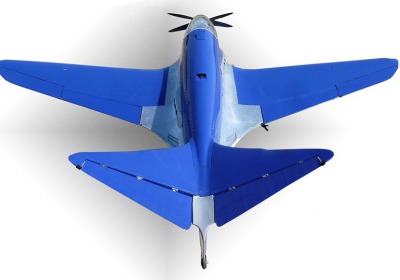Bugatti's 100P dream airplane to soar for the first time at the Mullin Automotive Museum
Tue, 11 Feb 2014
Ettore Bugatti, perhaps bored with building such extravagant symbols of single-minded genius like the Royale, devised a staggering work of aeronautical wonder that never saw the light of the day. Threatened by the twin insurmountable forces of deadlines and war, the Bugatti 100P never made it to the skies.
Bugatti wanted to tackle the Deutsch de la Meurthe Cup Race -- the brainchild of one Henri Deutsch de la Meurthe, the wealthy petroleum businessman who birthed Europe's oil industry in his native France. The "Oil King of Europe" loved aviation so much he assembled multiple races, beginning in 1900, with a prize of 10,000 francs to the first person who could fly from the Parc Saint Cloud to the Eiffel Tower in half an hour. The balloons shone here. Then, in 1904, he offered 50,000 francs to fly a 1-kilometer loop, which was won in 1908 by Henry Farman, operating a Voisin II biplane. A Voisin -- of course!
In the case of the 1912 Coupe Deutsch de la Meurthe, the rules were simple but far more ambitious: One needed to fly two flights of 1,000 kilometers each in a loop over Paris, in an airplane whose engine was smaller than eight liters. How much difference a decade makes. It cost only 2,000 francs to enter, but the prize was 10 times that. In 1936, the last time the race was held, a man named Yves Lacombe won. The next race was scheduled for 1939, but the French aircraft industry was busy tackling the potential German invasion, and the race was cancelled. No matter: Ettore missed the September deadline on his Bugatti 100P anyway.
The Bugatti 100P is a delicate, otherworldly thing. Painted in Bugatti's trademark blue, it looks like it couldn't have possibly come from the 1930s. Rounded forward-swept wings, a V-tail, retractable landing gear, twin contra-rotating front props: Was this craft from outer space? Two Bugatti 50B straight-eight engines powered the propellers and produced 450 hp each; Ettore estimated that it could reach 500 mph.
Mullin Museum
The insectoid Bugatti 100P was far ahead of its time.
Bugatti never flew his Bugatti 100P, instead tucking it away from the Germans for the duration of the war. Amazingly, it survived the war, and it survived multiple sales afterward, even after it lost its engines to restorations of Bugatti cars. In 1971, a full restoration effort was mounted. It is now stored at the Experimental Aircraft Museum's AirVenture Museum in Oshkosh, Wis.
In 2009, three men began building a faithful recreation of the Bugatti 100P, constructed mostly by hand and following Ettore's drawings and patents with the utmost faith. In 2014, the three--Scott Wilson, John Lawson and Simon Birney of Le Reve Blue -- finally finished. And in March, the result will make its way to the Mullin Automotive Museum in Oxnard, Calif.
We at Autoweek love the Mullin Automotive Museum, mostly because we wish we were a steampunk Jay Gatsby behind the wheel of the brain-fricasseeing 1938 Dubonnet Hispano-Suiza H6C Xenia. We also like Peter Mullin, mostly because he has impeccable taste in cars, colleges and charities. It seems fitting for Mullin -- who, starting March 20, will host the largest collection of Bugatti automobiles, furniture, and paintings from the Bugatti family in the world -- to feature a faithful, airworthy re-creation of the beautiful and rare airplane, in addition to seeing it fly for the first time.
Yes, the finished 100P will make its debut in Oxnard as part of the Art of Bugatti exhibit before it takes to the skies for the first time. We imagine Ettore would be proud, for two reasons: The Nazis have been long defeated, and his vision of aviation future will finally see beautiful, blue California sky.
By Blake Z. Rong

